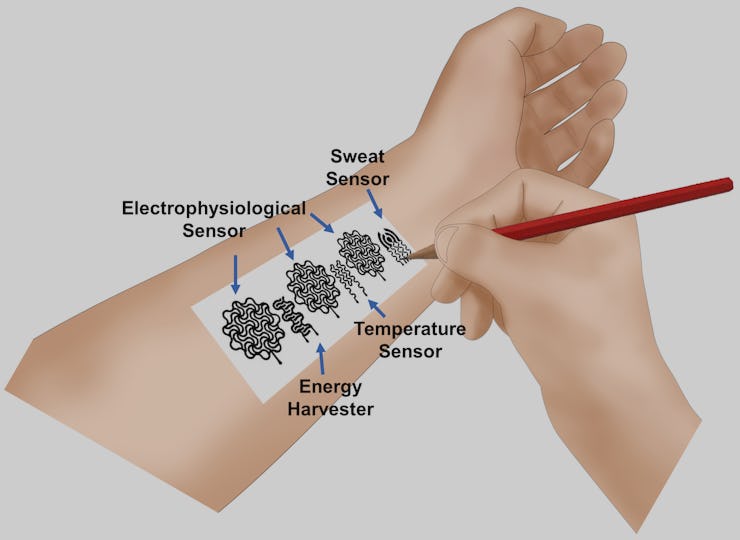One elementary school staple is the future of medicine
This gives a whole new life to the humble #2 pencil.

Biosensors tracking your body's every health signal could be the future of personalized medicine, but many of these devices are expensive and ultimately harmful to the environment. Sensors designed for intermittent use can rack up as much as $10,000 per unit and single-use biosensors -- while cheaper -- are not often not biodegradable and can quickly amass a ton of waste.
As an alternative, a team of researchers has designed a sensor that can reliably track your health in real-time using only everyday printer paper and a pencil.
What's the news -- In a new study published Monday in the journal PNAS, a team of biomedical engineers from the University of Missouri has revealed a design for biomedical sensors that could be fabricated using only traditional printer paper and a classic #2 pencil. Because these materials are readily available nearly ubiquitously around the world and are cheap to manufacture, the authors write that this approach to developing biosensors would be much more accessible than designs that use rare or expensive materials.
Additionally, because paper is a natural product made from cellulose (aka, tree pulp,) the authors argue that these paper-based sensors would much more biodegradable than their synthetic counterparts. If the future of medicine is real-time analysis through biosensors, discarded synthetic sensors would pile up quickly.
In their paper, the researchers explored a number of different applications for these simple sensors, including glucose, pH, temperature, heart rate, and respiratory rate monitoring.
Intricately drawn patterns on this paper sensor can detect a number of important biological signals.
How does it work -- A biosensor is made up of two main parts: a substrate, which is essentially just the foundational layer of the device, and a conductive material that can collect and carry electric and chemical information from the body. In this study, the substrate was paper and the conductive material was graphite left behind from writing with a pencil.
Different, serpentine-like designs were drawn on pieces of paper -- such as a squiggle-filled flower design which collected electrophysiological signals -- and then stuck to five participating volunteers using a small amount of adhesive.
Zheng Yan, the study's lead author and assistant professor of biomedical, biological, and chemical engineering at the University of Missouri, tells Inverse that the shape of these intricate doodles plays a big role in the effectiveness of these graphite electrodes.
"The use of open-mesh, serpentine-like layouts of these biosensors can help minimize [the] local strain of these conductive pencil-drawn graphitic electrodes, and thus maintaining their electrical properties when they are subject to stretching or bending deformations," says Yan."If other shapes are used, for instance, the conductivity of a straight line would degrade upon mechanical deformations, which is not suitable for on-skin electronic devices.
These biosensors are connected to external instruments that collect and analyze the health information in real-time. In the future, Yan tells Inverse that the team plans to incorporate wireless transmission of this data directly to a visual display, like a smartphone.
What were the results -- When comparing the biological signals collected from their paper sensors to data collected from secondary sources (e.g. in addition to respiratory rates from the sensor the team also manually counted participants' breaths) the team found that their sensor was largely on par with expected values.
The team also found that their device was stable and reliable through participants' sweating and even through purposefully drenching it in water.
What's next -- Yan tells Inverse that the success of this simple design is encouraging for the future of these devices, which could be an essential part of complete, dynamic healthcare in the future.
"These inexpensive and biodegradable biosensors can find wide applications in low-resource environments and home-centered personalized healthcare owing to their low-cost resources, handy operation, time-saving fabrication, and abundant potential designs," says Yan. "They could also be potentially used in [a] clinical setting for electrophysiological signals (e.g., ECG, EMG and EEG) recordings due to their intrinsic biocompatibility and easy removal. However, the development of these biosensors is still in the infant stage, and therefore it is too early to provide a timeline for the adoption."
Abstract: Pencils and papers are ubiquitous in our society and have been widely used for writing and drawing, because they are easy to use, low-cost, widely accessible, and disposable. However, their applications in emerging skin-interfaced health monitoring and interventions are still not well explored. Herein, we report a variety of pencil–paper-based on-skin electronic devices, including biophysical (temperature, biopotential) sensors, sweat biochemical (pH, uric acid, glucose) sensors, thermal stimulators, and humidity energy harvesters. Among these devices, pencil-drawn graphite patterns (or combined with other compounds) serve as conductive traces and sensing electrodes, and office-copy papers work as flexible supporting substrates. The enabled devices can perform real-time, continuous, and high-fidelity monitoring of a range of vital biophysical and biochemical signals from human bodies, including skin temperatures, electrocardiograms, electromyograms, alpha, beta, and theta rhythms, instantaneous heart rates, respiratory rates, and sweat pH, uric acid, and glucose, as well as deliver programmed thermal stimulations. Notably, the qualities of recorded signals are comparable to those measured with conventional methods. Moreover, humidity energy harvesters are prepared by creating a gradient distribution of oxygen-containing groups on office-copy papers between pencil drawn electrodes. One single-unit device (0.87 cm2) can generate a sustained voltage of up to 480 mV for over 2 h from ambient humidity. Furthermore, a self-powered on-skin iontophoretic transdermal drug-delivery system is developed as an on-skin chemical intervention example. In addition, pencil–paper-based antennas, two-dimensional (2D) and three-dimensional (3D) circuits with light-emitting diodes (LEDs) and batteries, reconfigurable assembly and biodegradable electronics (based on water-soluble papers) are explored.